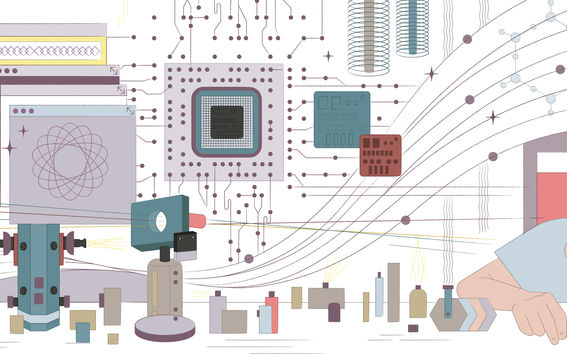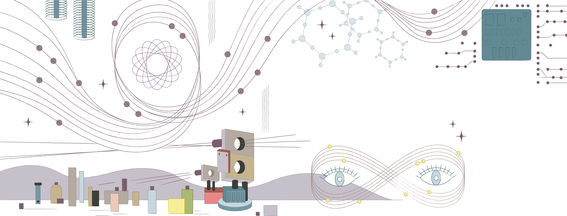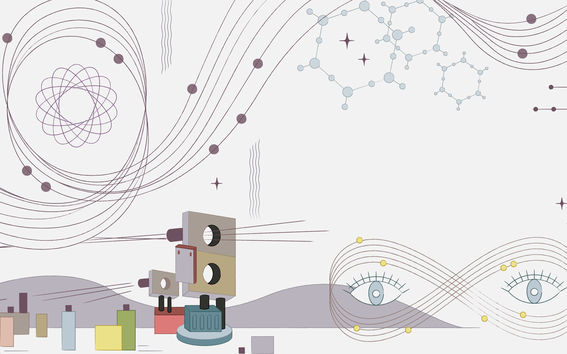The science of light is everywhere

Photonics is a subset of physics, and it’s being heralded as the new frontier for the next generation of devices and technologies that will be light-speed fast, sustainable, efficient and cost-effective, and all this at great benefit to our society. Together with nanoelectronics, nanotechnology and biotechnology, it has been recognised as one of the key enabling technologies (KET) that are seen as the essential building blocks for future technological innovation across all sectors by the European Commission. However, even with a rising profile, it can still be a challenge to attribute its significance, says Juha Purmonen, Executive Director of Photonics Finland.
‘Photonics is an enabling technology, which means that photonics is itself invisible, but when you use it in other solutions then it becomes a crucial element.’
New uses of light
Some of the more prominent areas where photonics is applied are information and communication, manufacturing, life science and health, lighting and displays, security, energy metrology, imaging and sensors.
Assistant Professor Caterina Soldano at Aalto University explains that even though photonics is commonly seen as a new thing that has led to some of today’s coolest applications and devices, any process through which light is created is actually relatively old.
‘We could think of early examples like the first Tungsten lamp or eye-glasses, as well as many other instances. However, current scientific understanding and knowledge, along with technological advancement, have led to completely new ways of creating, manipulating and detecting light, and laser technology is a perfect example of this.’
The history of photonics could also be a history of the laser, and since the laser was first invented nearly sixty years ago, the range of applications has had an immeasurable impact on humanity, over a vast array of fields. Even though laser-driven technologies have been awarded the Nobel Prize in physics for the last two years, the prizes represent the research and innovations in the decades preceding.
Professor Zhipei Sun is the leader of the research group in photonics at Aalto. He breaks up the field of fundamental photonics development into four core groups: generation, modulation, propagation and detection.
‘Photonics has traditionally been concerned with getting emissions of light, such as from lamps or LEDs, but now it’s moving more towards making the light emissions more efficient while trying to increase efficiency in controlling the photons.’
As manufacturers are approaching the limits of what can be achieved through conventional technology, the field of photonics is creating exciting new opportunities. Gaming and entertainment would be the most apparent applications of new photonics technologies and might be the primary driver of consumer interest, but the omnipresence of photonics and its potential to transform society, business and industry cannot be understated.
‘As just one example, the internet can’t work without photonics as nearly all data goes through optical fibres. In the future, data centres need more capacity, and light-based technologies will supplement or replace current electronics/electric-based technologies, so from a business point of view, photonics will cover many current solutions and open new possibilities,’ says Purmonen.
Executive Director Juha Purmonen, Photonics Finland‘As just one example, the internet can’t work without photonics as nearly all data goes through optical fibres.’
No plateau for photonics applications
Photonics communication technologies are at the optical heart of transforming modern society where data will be transmitted at an ultrafast pace in millions of extended fibre-optic networks in every home around the globe. These light-based technologies, therefore, feed new artificial intelligence algorithms to enable autonomous driving, smart cities, industry 4.0 as well as a comprehensive understanding of our climate.
Industrial manufacturing will consist of an entire end-to-end digital value chain, from supplier to customer, which will create new business models, enabling new methods of collaboration and service.
Photonics technologies in health sciences will contribute to the development of mobility optimised wearables that, combined with state-of-the-art biosensors, will give instantaneous diagnostics, catching diseases earlier on, as well as monitoring and assessing treatment responses, heralding the age of precision medicine. On the horizon is the ability to search and detect biomarkers for serious (and as yet incurable) diseases.
Photonics in lighting, electronics and displays will replace the more traditional navigation and information systems, which monitor user habits and preferences, and can offer more personalised information as a result. This could be through facial recognition technologies or health monitoring wearables. These technologies could be utilised in a whole range of applications such as in commerce, entertainment, and industrial planning to name only a select few. The advancements of these technologies will also be requisite in the looming self-driving boom, with several challenges addressed, such as improving road safety and reducing congestion.
From agriculture to laser surgery
Less apparent is the effect photonics will have on food and agriculture, with challenges coming both from population growth and environmental issues in how food security will be approached. Purmonen says, ‘I believe that the food and agriculture sectors need a lot of photonics innovations, and it starts from the field and continues to branch outwards into all facets of production. There is a need for food production to be economical, less wasteful and environmentally and socially sustainable.’
Light-based technologies are invaluable in monitoring and measuring tools, on farms, in food processing plants and the consumer’s hands. Sensors that can monitor soil quality and crop yields will give valuable insights into possible actions to get the best results.
Professor Sun says photonics-enabled improvements could be made in data transfer, as there is a need to both increase the speed and capacity of data transfer, as well as to control the energy input and output required. Intel just announced a new silicon photonics solution with a pumped-up data transfer rate of up to 400Gb/s, offering ten times the speed and longer distances while saving a substantial amount of power compared to traditional copper cabling.
Laser surgery is another example where improvements could be transformative. Laser surgery currently works at a one-micron wavelength which operates at the near infra-red. Professor Sun says, ‘The main reason for working at one micron is that we can easily get high power at that range. A better wavelength would be at two microns, and the reason is that our body consists of 90% water. The two-micron wavelength is not transparent to the water layer, so much better and more precise surgical cutting and removing can be performed with less damage to healthy tissue.’
Aalto delves deep
Most of the photonics-related research groups at Aalto are located in Micronova, an Aalto University and VTT Technical Research Centre of Finland-run facility in Espoo for research on micro- and nanotechnology. Professor Zhipei Sun and his team at Aalto are dedicated to investigating the unique properties of different nanomaterials that could be utilised for various photonic applications in the future.
‘One of my personal views is to make all photonics devices on-chip with high performance. For example, highly integrated, highly sensitive and fast photonic sensors as well as imaging and computing devices will support the current Internet of Things revolution, where machines can see, think, decide and communicate, transforming our society.’
While Sun and his colleagues are working on photonics more from a fundamental side, Professor Caterina Soldano works from an application-driven approach, with the goal of developing new and innovative devices and applications.
‘I research optoelectronics, which uses organic molecules instead of conventional materials like silicon, to generate and detect light, and I aim to play a crucial role in developing next-generation optoelectronics. Organic materials enable a novel class of devices which, along with traditional properties, can also be flexible and conformable. This would allow such things as medical devices to adapt to body movements, clothing with integrating sensors or foldable mobile telephone displays. Working across the fundamental research and R&D environment has provided me with a broader perspective on how to bring a laboratory object to a close-to-market application. Here at Aalto, my goal is to combine those aspects, and I will mainly guide the results towards practical applications.’

Photonics and Finland
The development of photonics-based solutions in Finland crosses the spectrum between global and local challenges/solutions.
‘If we think about photonics from a technology point of view, VR, AR and MR are great examples of big things being developed in this country by companies such as Varjo Technologies and Dispelix, both of whom are producing world-class solutions,’ says Juha Purmonen, Executive Director of Photonics Finland.
In addition to VR/AR/MR, there are 200+ companies in Finland developing a wide array of solutions with optical sensing and imaging, micro and nanophotonics, and lasers and fiber optics, and these technologies are used in everything from laser surgery to data transfer, displays and sensors. With Finland’s considerable forestry inventory, photonics has begun to figure quite heavily in a technology called Lidar (Light Detection and Ranging) that, when deployed on drones, can monitor and control forest fires and forest inventory.
The Academy of Finland Flagship Programme selected the most important themes for Finland’s future and subsequently grouped them into six different flagships. One of them is PREIN – Photonics Research and Innovation.
It is a light-based technology competence cluster of 300+ personnel collaborating on multi-disciplinary science, industry, and society. The initiative combines the extensive resources and infrastructures of all partners, including Aalto University, University of Tampere, University of Eastern Finland, and VTT Technical Research Centre of Finland Ltd.
It covers the whole value chain from fundamental research to applied research, product development and commercialisation.
The PREIN Flagship was recently awarded the Aalto Research Impact for 2019.

Enormous growth potential
-
Photonics is expected to generate one million new jobs in Europe by 2030.
-
Today, there are more than 200 photonics companies in Finland alone.
- Photonic technologies have a significant impact on the world economy. The global market value of photonics is projected to exceed €600 billion in 2020.
-
The photonics industry’s growth rate was more than double that of worldwide GDP growth in 2005-11.
-
Photonics impact around 10% of the European economy.
-
The European photonics market is worth €58.5 billion (21% of the world market) and the European photonics industry employs 290 000 people.
Source: Photonics21 Multiannual Strategic Roadmap 2021–2027
Text: Mark Fletcher.
This article is published in the Aalto University Magazine issue 25, October 2019.
Read more news

Unite! Seed Fund 2026: Open for applications
The 2026 Unite! Seed Fund call is officially open, offering funding across three strategic lines: Student Activities, Teaching and Learning, and Research and PhD. Deadline for applications is 20 March 2026.
Apply now: Unite! Seed Fund 2026 - Student Call
The Unite! Seed Fund call for 2026 is now open for students. Apply now for up to €20,000 per project, involving at least two Unite! Universities. Deadline for applications is 20 March 2026.






